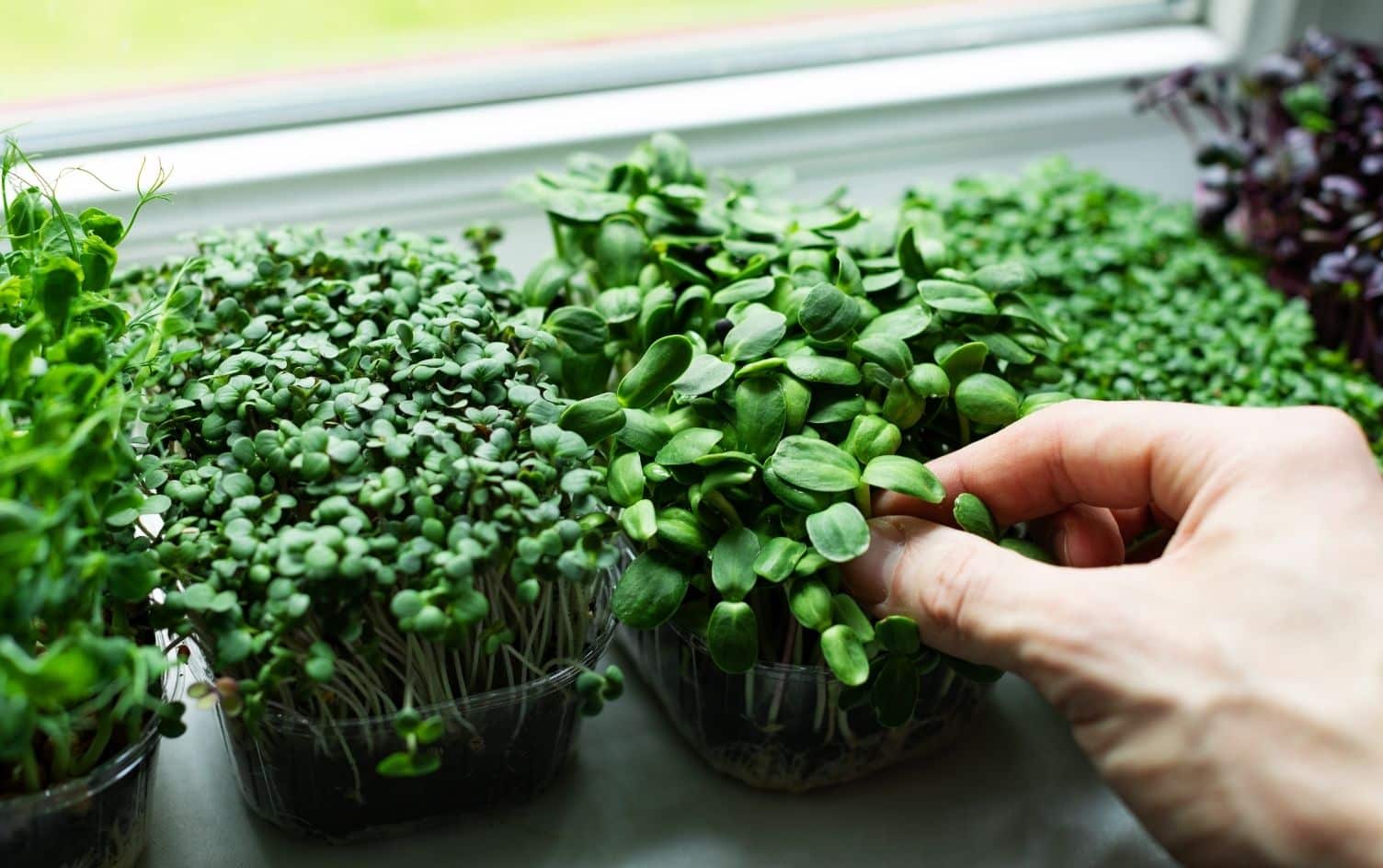With more time at home during the novel coronavirus pandemic, many people took on new hobbies. One that seems to have stuck is gardening. Research shows that 55% of American households participate in gardening activities. If you’d like to grow some of your own food but don’t have the yard or free time for a large plot, you can still plant seeds and reap the benefits of your harvest with microgreens.
“Microgreens are the edible leafy greens of many vegetables, herbs, grains and flowers that are harvested within about two weeks from seedling emergence,” says Sarah Ardanuy Johnson, PhD, RDN, assistant professor and director of the Functional Foods and Human Health Laboratory at Colorado State University and lead author of a recent study on microgreens. Often used as colorful, funfetti-like garnishes for fancy restaurant dishes, microgreens fall somewhere between sprouts and baby greens in size. As such, they don’t take much space to grow and can easily fit on your windowsill offering a tasty mix-in for soups, salads, and more.
Ready in a few weeks and rich in nutrients, microgreens might just be the new sprouts (and, since they’re eaten without the roots, they also get higher marks for food safety). Here, everything you need to know about these greens — including their health benefits, how to grow your own, and a few flavorful varieties to add to your garden.
WHAT’S SO MIGHTY ABOUT MICROGREENS?
Research suggests microgreens are more concentrated in many vitamins, minerals and phytochemicals (naturally-occurring plant chemicals linked to numerous health benefits) than their mature counterparts, says Johnson. In fact, microgreens generally contain about five times more vitamins and phytochemicals compared to full-grown plants, per a study published in the Journal of Agricultural and Food Chemistry (a good reason to include them in the recommended 8–10 servings of fruits and veggies a day).
Another benefit is microgreens may also have a reduced environmental footprint, says Johnson. Since they can be grown year-round, indoors, in cities and rural areas, and without much water, they’re a highly sustainable veggie, whether you pick them up from a local farmer, a nearby grocery store or grow them in your own home.
HOW TO GROW MICROGREENS
If you’ve ever picked up a carton of microgreens at the store, you know they can be expensive. Luckily, you can easily grow your own. To start a microgreens garden, you’ll need:
- Growing trays
- Growing medium such as potting soil or coconut coir
- Microgreens seeds
- Spray bottle
- Natural light or LED grow lights
While these supplies can be bought separately, if you’re new to gardening (or lack a green thumb), Johnson recommends purchasing a grow kit. True Leaf Market and Hamama, among other companies, sell kits that come with everything you need to grow microgreens.
Then, follow this simple, step-by-step guide:
STEP-BY-STEP GUIDE TO GROWING YOUR OWN MICROGREENS
1. FIND A SUNNY SPACE
You can grow microgreens inside, on your porch, balcony or in the corner of your yard. Just make sure to find a spot that gets plenty of sunlight during the day (like a south-facing windowsill).
2. PREPARE YOUR PLOT
Cover your growing tray with 1–2 inches of soil and gently pat it down.
3. SCATTER YOUR SEEDS
After reading the seed packet for any special instructions, sprinkle your microgreen seeds atop the soil and cover them with a thin layer of soil. Give them a light spritz with a spray bottle.
4. TEND TO YOUR GARDEN
For the next two weeks or so, mist your plot once or twice a day.
5. HARVEST YOUR MICROGREENS
When your microgreens have reached about two inches in height and have sprouted their first set of leaves, they’re ready to eat. Using kitchen scissors, snip them just above the soil, rinse them off and enjoy.
MICROGREEN VARIETIES TO TRY
Like leafy greens and fresh herbs, microgreens can impart a unique flavor depending on which type you choose. Just about any plant can be raised as a microgreen, from basil and cilantro to beets and mustard greens. Here are four Johnson recommends for newbie gardeners:
1. RED CABBAGE
Vibrant red cabbage microgreens receive top marks for appearance and have a little kick, says Johnson. Mix them into sandwiches or dishes that could use some heat, she suggests.
2. ARUGULA
High on heat, bitterness and intensity, arugula microgreens make a smart pick for someone who wants more flavor. Use them to spice up otherwise “bland” dishes or try them on top of your avocado toast, says Johnson.
3. BROCCOLI
Think of broccoli microgreens as a “toned-down” alternative to spicier red cabbage and arugula microgreens, says Johnson. All in all, they make for a delicious grain bowl topping and can hold their own as a side, too, she says.
4. RED BEET
If you love the taste of beets, you’ll love red beet microgreens (they unsurprisingly have a similar taste, notes Johnson). Mix them into salads and dishes that would benefit from a beet-like flavor or blend them into a smoothie, she says.
Originally published July 2020, updated April 2023
Ready to take the next step? Unlock MyFitnessPal Premium to access custom goal settings, quick-log recipes, and guided plans from a registered dietitian. Premium users are 65% more likely to reach their weight loss goals!




